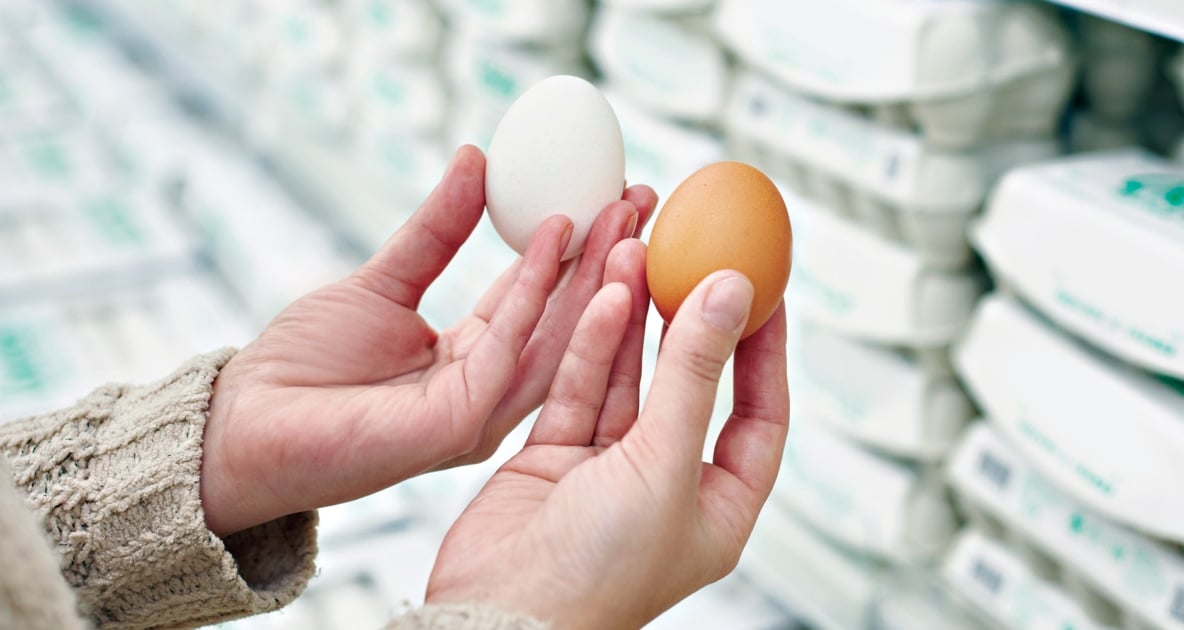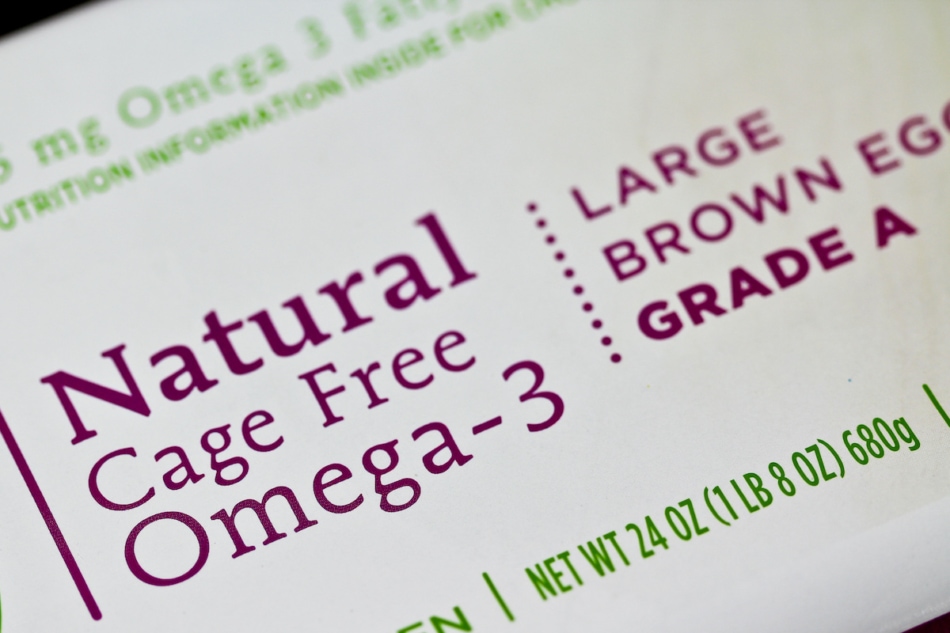How Much Do You Know About Eggs?
Where do supermarket eggs come from? Are brown eggs better? Is free-range better than pastured? We help you sift through all the terms.

Americans purchase and eat more than 80 billion eggs per year. Darting into the grocery store for a carton of eggs is no longer a simple task. There are so many categories of eggs to choose from, with many new terms and changes in labeling introduced as consumer demands to know exactly what they’re buying have increased. So how do you know what you’re getting when you’re purchasing eggs from the supermarket or farmers market? We help you sift through all the terms.
Where Do Supermarket Eggs Come From?

It’s essential to first consider where the bulk of our eggs are produced, and how they are raised. According to the United Egg Producers U.S. stats, 99% of the eggs sold in stores come from approximately 186 egg-producing companies with flocks consisting of 75,000 laying hens or more. And 63 of these companies have one million or more laying hens, with 17 companies having more than 5 million laying hens.
Read: How fresh are those supermarket eggs?
When Buying Eggs, What Do All The Terms Mean?

Here is a breakdown of what each of the labeling terms actually mean on egg cartons:
Farm Fresh: The traditional egg farm with less than 400 egg-producing hens led to the creation of large commercial egg operations. While the eggs produced are generally fresh, they’re not from a “farm” in the traditional sense. The chickens most likely were conventionally raised, in “battery cages” (the name given to rows and columns of identical cages connected together, in a unit) without access to the outdoors, unless the carton also specifies pasture-raised.
Hormone-free: In the U.S., industry regulations forbid the use of hormones in raising chicks and egg-laying hens. Since all eggs sold in the supermarket are hormone-free it is not necessary to note this on the packaging.
Vegetarian-Fed: Vegetarian-fed chickens have a diet limited to grains and soy protein. These eggs appeal to consumers on a Lacto-Ovo Vegetarian diet. But chickens “in the wild” are omnivores and eat grass, seeds, and insects. This labeling term ensures they weren’t fed animal by-products.
Naturally Pasteurized: This term means the eggs were pasteurized through a warm water process to eliminate the risk of consumers incurring illness or death from possible salmonella. Unfortunately, this term is often used to mislead consumers about the egg-laying conditions when, in fact, it’s unrelated.
Cage-Free: 5.5% of table eggs sold in the U.S. market are labeled “cage-free” which means they were raised free of cramped cages sounds, but the chickens are raised indoors in overcrowded production facilities.
Free-range: Free-range simply means the hens have access to the outdoors. There are no regulations specifying the frequency of their outside access or the size of the space. Unless you are purchasing eggs from a sustainable farm, it is not likely that the chickens ever roam outdoors.
Organic: 4.5% of table eggs sold in the U.S. market are labeled organic. To qualify for this labeling, USDA Certified Organic egg producers must not use genetically modified feed or antibiotics in their operations.
Pastured: Chickens are allowed to forage naturally outdoors on grass, seeds, and insects during the day in addition to receiving feed. Organic, pasture-raised is by far the healthiest way to raise chickens, which produce the healthiest, most nutritious eggs. This is the preferred method used by sustainable farmers. Pastured eggs still retain the bloom, the protective coating on the outside of eggs.
All Eggs Are Not Created Equal
The quality and nutritional value of the eggs you select is determined by the feed, and environment the chickens were raised in. Restricting chickens of their natural foraging for food outdoors and placing them in an unhealthy, crowded building makes them prone to disease. The best way to ensure that you get quality eggs is to do your research. Ask your grocer or local egg producer what the chickens are fed and how they are raised. Shopping at the farmers’ market or a local sustainable farm gives you the opportunity to ask questions and speak directly to the producer. If zoning and location permits, treat yourself to the freshest eggs ever and consider raising a small flock of laying hens in your fenced yard.
Nutritional Value of Eggs
Eggs not only contain the highest quality protein available, but they also contain almost every essential vitamin and mineral needed by humans (except vitamin C). The big concern about eggs used to be the link between their cholesterol content and heart disease. Yet, recent studies reveal that one large egg contains:
70 calories
1 gram of carbohydrate
4.5 grams of fat (with only 1.5 of the grams being saturated fat)
6 grams of protein
213 milligrams of cholesterol, 22 percent less than previously thought based on a 1989 study.
Eggs – Making The Size and Grade
Size: Eggs are available as jumbo, extra-large, large, medium, and small.
Grade: In the grading process, eggs are examined for both interior and exterior quality, and are sorted according to weight (size). Grade quality and size are not related to one another. In descending order of quality, grades are AA, A, and B. There is no difference in nutritive value. In many egg-packing plants, the USDA provides a grading service for shell eggs. Its official grade shield certifies that the eggs have been graded under federal supervision, according to USDA standards and regulations. The grading service is not mandatory. Other eggs are packed under state regulations that must meet or exceed federal standards. Because production and marketing methods have become very efficient, eggs now move so rapidly from laying house to market that you will find very little difference in quality.
Color: Most supermarket eggs are either white or brown, and there are no nutritional differences between them.
Myth Busting
According to Lisa Steele at Fresh Eggs Daily, finding a blood spot in an egg does not mean it’s been fertilized.
“A blood spot in an egg is simply a ruptured blood vessel that broke while the egg was being formed. In order to determine if an egg has been fertilized, you need to look for a white bulls-eye on the egg yolk.”
Got Any Egg Questions? Share them with us in the comments below!

Deborah Tukua
Deborah Tukua is a natural living, healthy lifestyle writer and author of 7 non-fiction books, including Pearls of Garden Wisdom: Time-Saving Tips and Techniques from a Country Home, Pearls of Country Wisdom: Hints from a Small Town on Keeping Garden and Home, and Naturally Sweet Blender Treats. Tukua has been a writer for the Farmers' Almanac since 2004.






So basically from what I’m seeing is buy from a farmer.
For pastured eggs to be sold off the farm grounds they must be washed and refrigerated as soon as possible after lay and meet all labeling and packaging rules also. These are state and USDA rules. So the bloom is washed off the eggs. Only eggs bought by the consumer on the farm grounds that have not been washed can claim they still have the bloom. We are Wamego Valley Farm selling pasture raised brown eggs in compliance with state and federal egg production and sale rules in the state of Mississippi. Also the outdoors element of free range production does not place a requirement for pasture, or other vegetation to be present. Free range outdoor access can be asphalt, sand, gravel, bare dirt, concrete, or wooden porch.